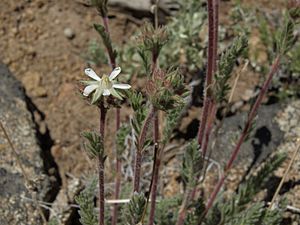White Mountains horkelia facts for kids
Quick facts for kids White Mountains horkelia |
|
|---|---|
 |
|
| Scientific classification | |
| Genus: |
Horkelia
|
| Species: |
hispidula
|
Horkelia hispidula is a special flowering plant that belongs to the rose family. You might know it better by its common name, the White Mountains horkelia. This plant is quite unique because it only grows in one specific place in the world!
Where Does the White Mountains Horkelia Live?
The White Mountains horkelia is what we call endemic to the White Mountains. This means it's found only there and nowhere else on Earth naturally. The White Mountains are a small mountain range located right on the border between California and Nevada. They are east of the much larger Sierra Nevada mountains.
This plant loves to live in dry, bushy areas. It also thrives in high-up, cool places like alpine and subalpine forests. Think of places where it's a bit chilly and rocky, even in summer.
What Does the White Mountains Horkelia Look Like?
The White Mountains horkelia is a type of perennial herb. This means it's a plant that lives for more than two years, and its stem is not woody like a tree. It grows close to the ground, forming a low, flat mat of leaves. These leaves are a greenish-gray color and feel a bit hairy and sticky because they have tiny glands.
The plant grows from a tough, woody base. Its leaves are shaped like cylinders and sometimes get narrower at the tip. They stand up straight in a cluster around the plant's main stem, which is called a caudex. Each leaf can be up to 10 centimeters (about 4 inches) long. They are made up of many small, hairy leaflets that are packed closely together.
How Does the White Mountains Horkelia Flower?
When it's time to bloom, the White Mountains horkelia produces an inflorescence. This is a fancy word for a cluster of flowers arranged on a stalk. This plant can have up to 15 flowers on one upright stalk.
Each flower is quite interesting! It has five hairy, pointed parts that bend backward. These are called sepals, which are like little leaves that protect the flower bud. Inside these sepals, you'll find five beautiful white petals.

